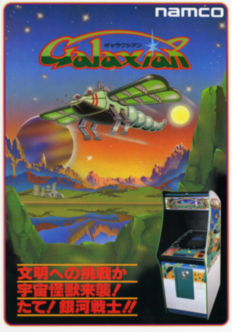
Galaxian is a 1979 fixed shooter arcade video game developed and published by Namco. The player assumes control of the Galaxip starfighter in its mission to protect Earth from waves of aliens. Gameplay involves destroying each formation of aliens, who dive down towards the player in an attempt to hit them.
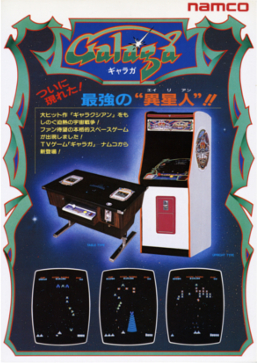
Galaga is a 1981 fixed shooter arcade video game developed and published by Namco. In North America, it was released by Midway Manufacturing. It is the sequel to Galaxian (1979), Namco's first major video game hit in arcades. Controlling a starship, the player is tasked with destroying the Galaga forces in each stage while avoiding enemies and projectiles. Some enemies can capture a player's ship via a tractor beam, which can be rescued to transform the player into a "dual fighter" with additional firepower.
Ace Combat is an arcade-style combat flight simulation video game franchise published by Bandai Namco Entertainment, formerly Namco. Debuting in 1995 with Air Combat for the PlayStation, the series includes eight mainline installments, multiple spin-offs, and other forms of media, such as novels, model kits, and soundtrack albums. Since 2012, the series has been developed primarily by Bandai Namco Studios through its internal development group, Project Aces.

Xevious is a vertically scrolling shooter arcade video game developed and published by Namco in 1982. It was released in Japan and Europe by Namco and in North America by Atari, Inc. Controlling the Solvalou starship, the player attacks Xevious forces before they destroy all of mankind. The Solvalou has two weapons at its disposal: a zapper to destroy flying craft, and a blaster to bomb ground installations and enemies. It runs on the Namco Galaga arcade system.

Ace Combat 5: The Unsung War is a 2004 combat flight simulation video game developed and published by Namco for the PlayStation 2. The game was developed by Project Aces, an internal Namco group credited with the development of the Ace Combat series. A limited number of the games were bundled with the Hori Flightstick 2 accessory.

Ace Combat 2 is a 1997 air combat video game developed and published for the PlayStation by Namco. It is the sequel to Air Combat and the second in the Ace Combat franchise. The player controls one of 24 different fighter jets through 21 different missions with certain objectives to fulfill, such as protecting a base from enemy fire, intercepting a squadron of enemies, or taking down an aircraft carrier.

Air Combat is a 1995 combat flight simulator developed and published for the PlayStation by Namco. Players control an aircraft and are tasked with completing a series of missions, with objectives ranging from destroying formations of enemies to protecting a specific target from enemy fire. Missions award money that is used to purchase new jet fighter, each with its own unique weapons and strengths.

Ace Combat Zero: The Belkan War is a 2006 combat flight simulation video game developed and published by Namco for the PlayStation 2. Part of the Ace Combat series, the game was first released outside of Japan by the newly formed Namco Bandai Games. Set in the Ace Combat series' fictional universe of Strangereal, the game's story takes place before the events of most other entries in the series, and follows the actions of "Galm Team", a mercenary fighter squadron led by the player character "Cipher", as they fight to repel an enemy invasion during the titular Belkan War, a World War II-esque conflict that was mentioned but not elaborated upon in previous entries.
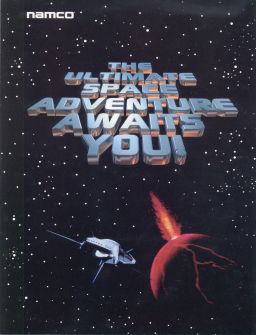
Galaxian3: Project Dragoon is a 3D rail shooter video game developed and published by Namco. It was originally a theme park attraction designed for the International Garden and Greenery Exposition in Japan, and was later released as an arcade game in 1992. The game involves players controlling a starship named the Dragoon in its mission to destroy Cannon Seed, a superweapon set to destroy what is left of the human race.

Ace Combat 3: Electrosphere is an arcade-style combat flight simulation video game developed and published by Namco for the PlayStation. The third game in the Ace Combat franchise, it was released in Japan in 1999 and in Europe and North America in 2000. Players control an aircraft and must complete various mission objectives, such as destroying squadrons of enemies or protecting a base from enemy fire.

Time Crisis is a first-person on-rails light gun shooter series of arcade video games by Namco, introduced in 1995. It is focused on the exploits of a fictional international intelligence agency who assigns its best agents to deal with a major threat by a hostile organisation, which has ranged from criminals, terrorists and hostile military outfits, and mostly take place within fictional locations across the world. The arcade series differed from other light gun shooters of its time by incorporating unique mechanics, including the ability to duck into cover to dodge attacks and reload the player's weapon, and forcing players to complete battles in each level within an allotted amount of time.

Super Mario Galaxy is a 2007 platform game developed and published by Nintendo for the Wii. It is the third 3D game in the Super Mario series. As Mario, the player embarks on a quest to rescue Princess Peach, save the universe from Bowser, and collect 120 Power Stars, after which the player can play the game as Luigi for a more difficult experience. The levels consist of galaxies filled with minor planets and worlds, with different variations of gravity, the central element of gameplay. The player character is controlled using the Wii Remote and Nunchuk and completes missions, fights bosses, and reaches certain areas to collect Power Stars. Certain levels use the motion-based Wii Remote functions.

Starblade is a 1991 3D rail shooter arcade game developed and published by Namco. Controlling the starfighter FX-01 "GeoSword" from a first-person perspective, the player is tasked with eliminating the Unknown Intelligent Mechanized Species (UIMS) before they wipe out Earth. Gameplay involves controlling a crosshair with a flight yoke stick and destroying enemies and their projectiles before they inflict damage on the player.

Galaga Legions is a 2008 twin-stick shooter video game developed and released by Namco Bandai Games for the Xbox 360. It is the twelfth game in the Galaxian series, and the third developed for home platforms. The player controls a starship, the AEf-7 "Blowneedle", in its efforts to wipe out the Galaga armada. The objective of the game is to clear each of the five stages as quick as possible. Stages have a heavy emphasis on puzzle solving and chain reactions, which are necessary to clear out enemy formations. The Blowneedle has a pair of satellites at its disposal, and can place them anywhere on the screen to fend off enemies.
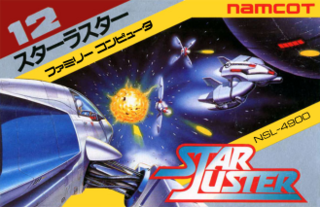
Star Luster is a 1985 space combat simulator video game developed and published by Namco for the Family Computer in Japan. and adapted for play in arcades via the Nintendo VS. System. Star Luster is set in the same universe as Namco's Bosconian (1981), and the gameplay has strong similarities to Atari's Star Raiders from 1979.
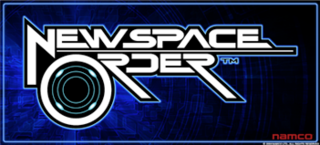
New Space Order is an unreleased real-time strategy arcade game under development by Namco Bandai Games for Japan. Controlling a fleet of battleships, players would explore the void of space to gather resources and fight off enemy fleets and destroy entire planets. Players could construct network systems to distribute resources to other players and construct new ship types to deploy into battle. The plot involves an intergalactic organization, the United Galaxy Space Force, discovering an unknown extraterrestrial species that plans to wipe out all of mankind. It was made for the Namco System N2 arcade board.

Star Wars: Flight of the Falcon is a video game based on the events of the original Star Wars trilogy of films, developed by British company Pocket Studios. Published by THQ for the Game Boy Advance, the game lets the player pilot various space ships in the battles against the antagonistic Galactic Empire. The story follows the pilots of the space ship Millennium Falcon, Han Solo and his Wookiee co-pilot Chewbacca, as they help save the galaxy from the Empire's forces.

Mr. Driller 2 is a puzzle video game developed and published by Namco, and the second game in the Mr. Driller series. It was released for the arcades in 2000, and was ported to the Game Boy Advance and Windows in 2001, and is available in emulated form via the Virtual Console on the Wii U. The game introduces two new characters to the series, Puchi, and Anna.

Starblade: Operation Blue Planet is an unreleased 3D rail shooter arcade game in development by Namco. A sequel to the game Starblade (1991), the player controls the GeoCalibur starship in its mission to wipe out an alien race known as the Unknown Intelligent Mechanized Species. Gameplay involved using a flight-yoke controller to control a crosshair and shoot down enemies, while avoiding incoming obstacles and projectiles. The player has a shield that depletes when inflicted with enemy fire. Only one level was completed. It ran on the PlayStation 2-based Namco System 246 arcade hardware.
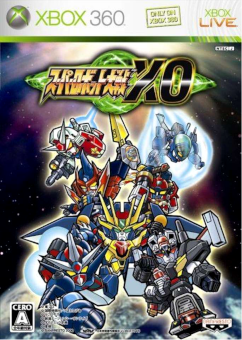
Super Robot Wars XO is a 2006 tactical role-playing video game developed and published by Banpresto for the Xbox 360 in Japan. Part of the company's Super Robot Wars series, it is an updated version of the GameCube installment Super Robot Wars GC (2004). Players control a fleet of mechas from a variety of super robot anime series, including Mobile Suit Gundam and Getter Robo, to defeat opponents on a grid-based map. XO combines tactical role-playing game mechanics with action sequences, which use stylized anime-esque cutscenes unique for each character.





















